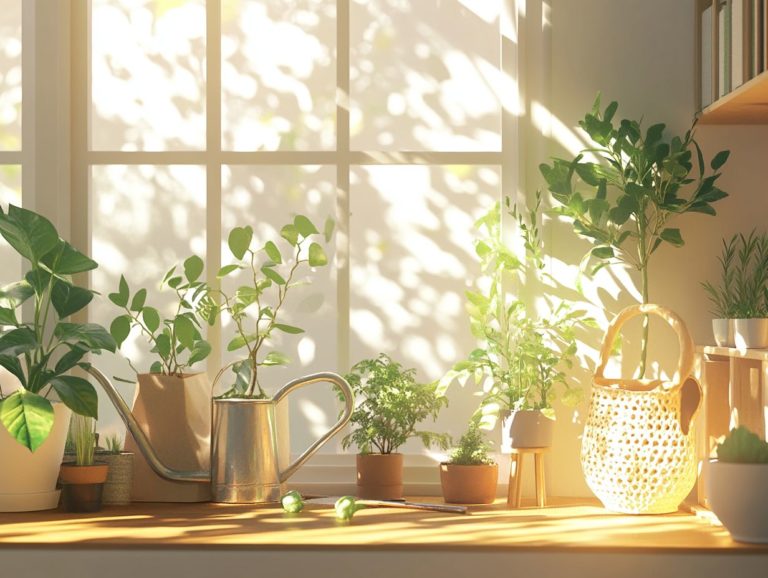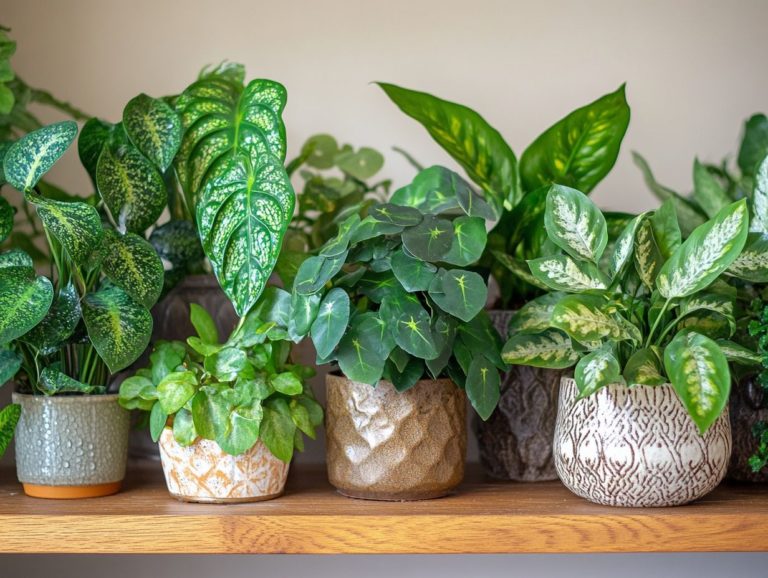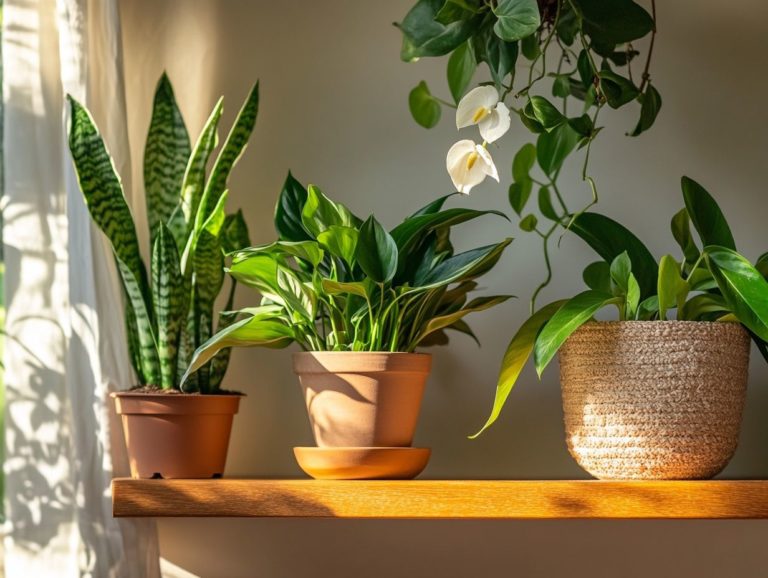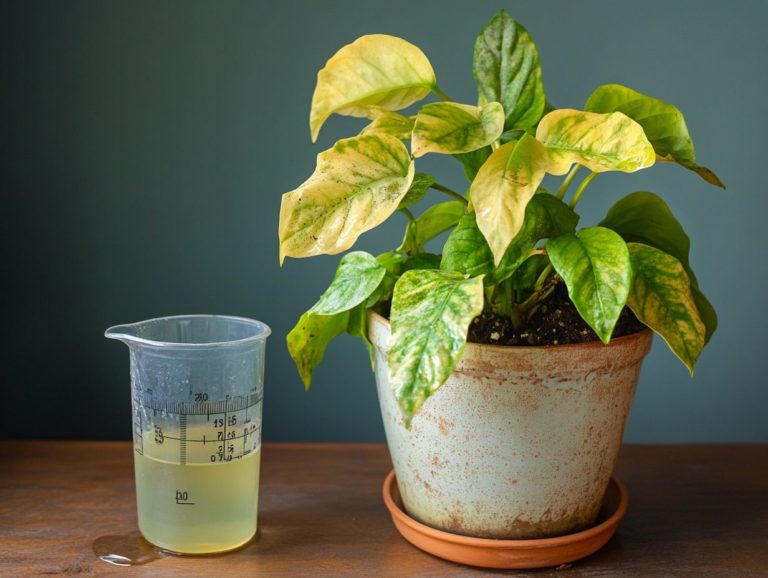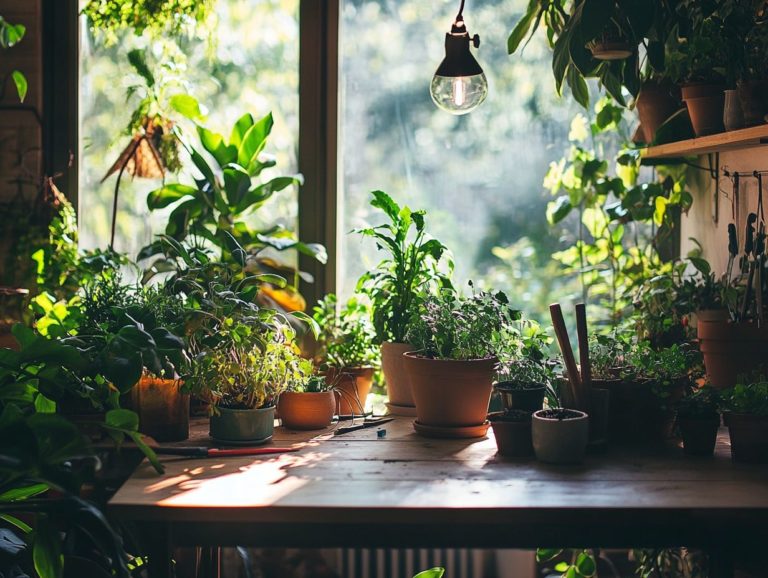How Do I Choose the Right Pot for My Plant?
Choosing the right pot for your plant is vital for its health and growth. A pot is more than just decoration; it affects how well your plant thrives.
Consider size, shape, drainage, and materials. These factors significantly impact your plant s success.
Get ready to discover the key elements that will elevate your plant care! This guide explores various pot types from classic terra cotta to innovative self-watering options and offers insights on pairing pots with different plant types to ensure your greens flourish.
Contents
Key Takeaways:

- Consider the size, shape, drainage, and material of a pot to enhance your plant’s growth.
- Pots come in many types, such as terra cotta, ceramic, plastic, and self-watering, each with its own benefits.
- Match your pot type to your plant type; for example, use terra cotta for succulents and ceramic for flowering plants.
Factors to Consider When Choosing a Pot for Your Plant
Selecting the right pot is essential for fostering the best growth and health. Factors like size, shape, drainage, and materials play a pivotal role in supporting roots and maintaining proper moisture levels.
Whether you’re a seasoned gardener or just starting out, understanding these elements can greatly influence your gardening success and enhance the overall aesthetic of your home.
Every type of plant, from tropical species to succulents, has specific needs that must be addressed to flourish in its chosen container. This highlights the importance of making thoughtful choices during the potting process.
Size and Shape
The size and shape of a pot significantly affect the health and growth of your plants. They determine the space available for roots to expand and access essential nutrients and moisture.
Choosing a pot that’s too small or too large risks disrupting this delicate balance, potentially leading to stunted growth or root rot. For instance, shallow pots might be perfect for certain succulents that thrive on good drainage but can restrict the root systems of deeper-rooted plants like tomatoes or bell peppers.
Oversized pots can easily become waterlogged, especially for herbs like basil or cilantro, which prefer to dry out a bit between waterings. By understanding the specific needs of each plant type, you can nurture robust root development, leading to healthier and more productive plants.
Drainage and Material
Proper drainage and the choice of material for your pots are crucial elements that greatly influence your gardening success. These factors help prevent root rot and ensure your plants receive adequate moisture.
When selecting pots, it’s important to consider different materials, as each offers its unique benefits and challenges. For example, fiberglass is lightweight and easy to move, while terra cotta provides excellent drainage. Terracotta is well-known for its breathability, allowing moisture to evaporate and promoting healthy root growth. However, it tends to dry out quickly in warmer climates.
On the other hand, fiberglass pots are favored by many gardeners for their ability to retain moisture for longer periods, along with their durability and lightweight handling.
Understanding how your soil type interacts with these materials is essential. Sandy soils, for instance, drain faster and may require more frequent watering when using terracotta pots. Regularly checking moisture levels and adjusting the soil ensures your plants thrive, no matter the pot material or soil mix you choose.
Indoor vs. Outdoor Plants
Knowing the differences between indoor and outdoor plants helps you choose the right pot. Each environment presents unique conditions, such as temperature variations and humidity levels, that can significantly impact plant health.
Indoor plants like peace lilies and snake plants thrive in controlled settings where light is filtered and temperatures remain consistently warm. They usually prefer pots that allow for good drainage while retaining some moisture.
On the other hand, outdoor plants like petunias and marigolds face the challenges of fluctuating weather, necessitating pots that provide excellent drainage and can handle temperature extremes.
Choosing the right materials like terracotta for outdoor use or ceramic for indoor specimens directly influences their growth and overall vitality. Grasping these nuances will help you ensure that both your indoor and outdoor plants flourish beautifully.
Types of Pots
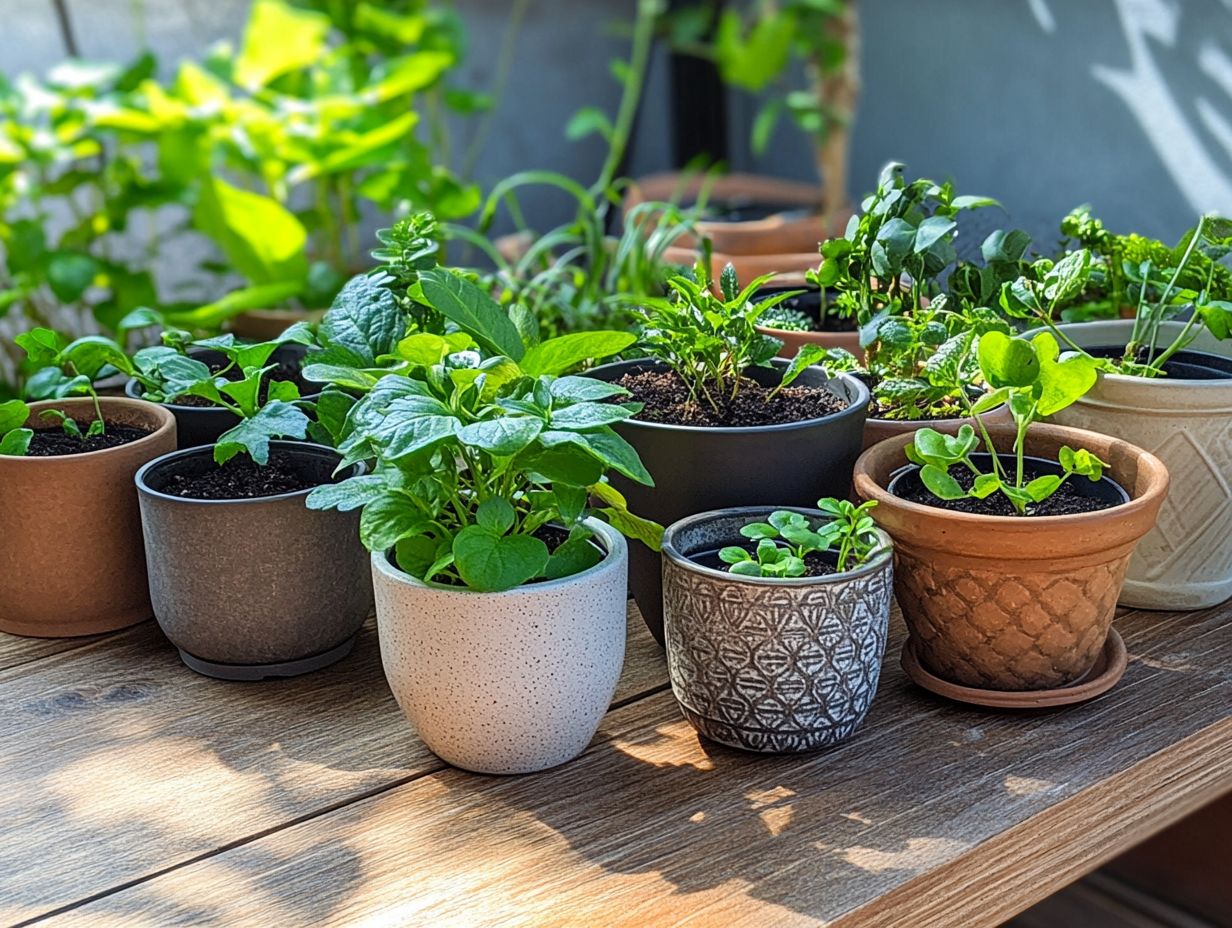
In the realm of gardening, knowing the diverse array of pots at your disposal enables you to make smart choices that cater to both your plants’ needs and your personal style.
Whether you prefer terracotta, ceramic, plastic, or self-watering options, understanding the nuances of each type ensures your selections are functional and visually appealing. Act now to ensure your plants get the best start!
Terra Cotta
Terra cotta pots have become favorites for gardeners, prized for their outstanding drainage capabilities and moisture-absorbing qualities. This makes them well-suited for a variety of plant species, especially those that thrive in drier conditions.
The rustic charm and natural earthy hue elevate the visual appeal of any garden, patio, or indoor space. They infuse it with warmth and authenticity. The porous structure of these pots encourages air circulation around the roots, fostering healthy growth for succulents and cacti.
To truly harness the advantages of terra cotta, it s essential to adopt a few care strategies. Regularly monitor moisture levels and use a well-draining potting mix. Placing a small layer of gravel at the bottom of the pot can help avoid moisture-related issues, facilitating drainage while preventing water from pooling around the roots.
Ceramic
Ceramic pots present different styles while ensuring optimal moisture retention for your plants. This makes them a top choice for anyone looking to elevate their indoor gardening game and home decor.
These containers enhance the look of your space while playing a vital role in the health of various plant species. For example, succulents and cacti thrive in ceramic pots, taking full advantage of the material s ability to regulate temperature and maintain moisture levels, effectively preventing overwatering.
Ceramic’s porous nature allows air to reach the roots, helping your plants thrive. With their perfect blend of durability and style, ceramic pots stand out as an ideal choice for cultivating diverse plant life while complementing your home s aesthetics.
Plastic
Plastic pots are lightweight and incredibly versatile, making them a convenient choice for gardeners at any experience level. However, it s crucial for you to select pots with adequate drainage to avoid excess moisture buildup.
These pots are affordable and accessible to both novice and seasoned gardening enthusiasts. They come in various sizes, giving you the flexibility to accommodate different plant types. Be aware that reduced breathability compared to other materials can impact root health.
To achieve the best results, look for pots with UV resistance to prevent discoloration and a thicker structure that enhances durability. When choosing plastic pots for your plants, prioritize those with drainage holes and select the right size for the specific root systems of your plants. This thoughtful approach will optimize their growth and overall health, helping you achieve gardening success.
Self-Watering
Self-watering pots are crafted for your convenience, enabling you to maintain consistent moisture levels. This is especially beneficial for plants that thrive on steady hydration.
These innovative gardening tools utilize a reservoir system a container that holds water below the soil, drawing moisture up through a wick or similar mechanism. This ensures that your plants receive the hydration they need without the constant need for monitoring.
This simplifies your care routine and significantly reduces the risk of over- or under-watering. Self-watering pots are perfect for various plant types, including herbs, succulents, and tropical varieties. They foster healthier growth and vibrant foliage, ultimately boosting your gardening success.
Matching Pots to Plant Types
Matching the right pot to each specific plant type is crucial for fostering healthy growth and development. Whether you’re nurturing succulents, cacti, flowering plants, herbs, or vegetables, it’s important to recognize their unique potting needs.
Choosing the right pot can really boost your gardening success!
Succulents and Cacti
Succulents and cacti flourish in pots that boast excellent drainage and minimal moisture retention. Terracotta or unglazed ceramic options are your best allies for these drought-tolerant plants.
These materials facilitate quick evaporation of excess moisture and help regulate temperature, both of which are crucial for the vitality of these resilient species. When selecting a pot, ensure it features drainage holes to prevent water from accumulating at the bottom. Standing water is a recipe for root rot.
For soil, opt for a specialized cactus mix or a blend that incorporates coarse sand or perlite, which is a lightweight material that helps with drainage. This combination strikes the perfect balance between aeration and moisture retention. Regularly checking moisture levels will inform your watering routine and guarantee that these hardy plants receive just the right amount of sustenance.
Flowering Plants
Flowering plants thrive best in pots that strike a delicate balance between moisture retention and proper drainage. This allows them to absorb the essential nutrients they need for those vibrant blooms you adore.
To achieve this equilibrium, opt for a well-draining potting mix made from peat, perlite, and compost. Clay pots are fantastic for plants like geraniums and petunias due to their breathability, while plastic pots excel at retaining moisture, making them ideal for moisture-loving varieties like impatiens.
When selecting pots, consider their shape and weight to ensure stability. Adding a layer of gravel at the bottom of the pot will boost drainage even further. When repotting, be mindful of pot size; a container that’s too large can lead to excess moisture retention, while one that’s too small may stunt growth. For optimal growth, learn how to find the right soil for your indoor plants and regularly check moisture levels, adjusting your feeding practices to ensure those blooms flourish beautifully throughout the season.
Herbs and Vegetables
When you’re growing herbs and vegetables, it’s crucial to select pots that facilitate easy nutrient management and provide ample space for root growth. This choice is essential for cultivating healthy, productive plants.
Ensure the size of the pots aligns with the mature dimensions of your plants. For instance, larger varieties like tomatoes will need deeper containers to accommodate their extensive root systems.
Material selection is equally important. Clay pots offer excellent breathability, allowing for better air exchange, while plastic pots tend to retain moisture perfect for those moments when you might forget to water.
Understanding soil types is also important. A well-aerated, organic potting mix enriched with compost can significantly improve drainage and nutrient retention, catering to the specific needs of your herbs and vegetables. This approach ensures that they thrive throughout the growing season.
Frequently Asked Questions
Q: What types of pots are best for succulents?
A: Pots with excellent drainage, such as terracotta or unglazed ceramics, are ideal for succulents.
Q: How often should I water my herbs?
A: Herbs typically require consistent moisture, so check the soil regularly and water when it’s dry to the touch.
Q: Is it necessary to fertilize flowering plants?
A: Yes, fertilizing flowering plants can enhance growth and promote vibrant blooms throughout the season.
Q: Can I use the same potting mix for all my plants?
A: It’s best to use specific potting mixes tailored to each plant type for optimal results.
In summary, selecting the right pots and soil types, along with proper watering practices, will set you on the path to a flourishing garden. Don’t wait to plant your herbs and vegetables correct pot selection can lead to a bountiful harvest!
What factors should I consider when choosing a pot for my plant?
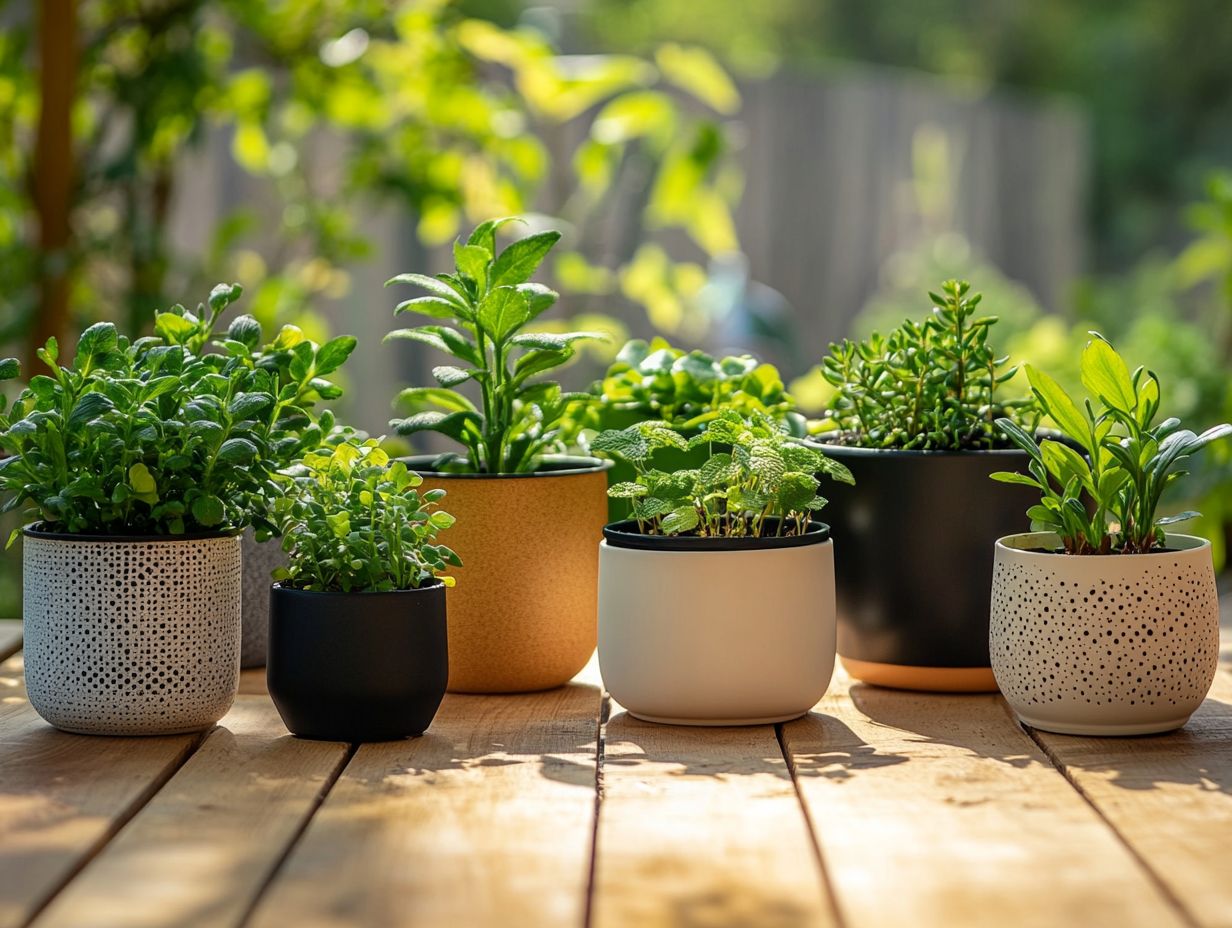
When choosing a pot, consider size, material, water flow, and style.
The pot should fit your plant well and look good in its surroundings.
Does the type of plant affect the type of pot I should choose?
Yes, different plants have different needs.
For example, water-loving plants need pots that drain well, while drier plants prefer breathable pots.
How do I determine the right size pot for my plant?
Choose a pot that is 1-2 inches wider than the current one.
This gives roots room to grow without feeling cramped.
What materials are best for pots?
Clay pots are excellent for drainage.
Plastic pots are light and hold moisture, while ceramic ones keep moisture levels steady.
Wooden pots allow for good air flow.
How do I know if my pot has proper drainage?
Fill the pot with water.
If it drains slowly, it may have too few holes or compacted soil. Quick drainage indicates good water flow.
Can I use any type of pot for my plant?
No, you must choose a pot that meets your plant’s needs.
The wrong pot can harm growth, so dive into some research to find the perfect pot for your plant!


